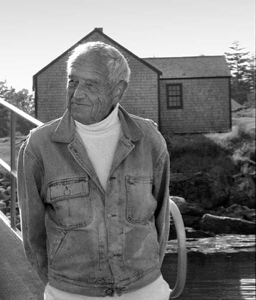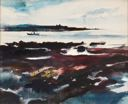Andrew Wyeth
American
(Chadds Ford, Pennsylvania, 1917 - 2009, Chadds Ford, Pennsylvania)
Andrew Wyeth was a phenomenon in American art since his first, highly successful exhibition at the Macbeth Galleries in New York in 1937. The exhibition sold out, and a legendary career began. Wyeth was compared, even at the young age of twenty, to the great American master of watercolor painting Winslow Homer. The critic Henry McBride offered high praise, saying, “Mr. Wyeth has the breadth of view that is associated with the name Homer…. He finds it easy to present you with clean, crisp water colors that immediately catch the eye.” (1) The American public soon came to share McBride’s enthusiasm, and Wyeth’s name and realist style are invariably linked with American art in the public consciousness.
Wyeth’s life and career are well documented. He was the youngest child of the illustrator N. C. Wyeth (1882–1945), who taught his son to draw and paint, beginning formal training when the boy was fifteen years old. Owing to his frail health, Andrew was home-schooled in the town of Chadd’s Ford, Pennsylvania. His proximity to his father, as well as the Brandywine River Valley around their home, inspired his own passion for art. The elder Wyeth formed his son’s technique, but did not impose his own style. N. C. Wyeth was eminently proud of Andrew’s early success, and his unexpected death in an automobile accident in 1945 changed the latter’s art profoundly. Until that point, he later reflected, “I just wanted to paint…. I was just a clever watercolorist—lots of swish and swash, but the seriousness, the dimension wasn’t there. I didn’t have much to say.” (2)
Subsequently, the artist sought solace in painting profound, moody works derived from his life in Chadd’s Ford, and from the area around his second home in Cushing, Maine. Wyeth formed a close bond with an older neighbor in Chadd’s Ford, Karl Kuerners, and the works he painted of the Kuerner family, their land, and their home are referred to as the “Chadd’s Ford Novel.” He also painted a group of works associated with his Maine home, the “Cushing Novel,” depicting the Olson family. The most famous is "Christina’s World" (1948, The Metropolitan Museum of Art, New York), depicting the young Christina Olson on a hillside. Like the Kuerner works, the Maine watercolors are fraught with implied drama and tension, conveyed by visual symbolism that is sometimes overt, but on other occasions is left purposely vague. Wyeth’s imagery reflects the isolation he felt from the larger world of American art, an isolation that was not unwelcome. “I came along at the right moment in American art,” he said. “I was fortunate because realism was at a low ebb. I was alone. I was an oddity. I was in an age when everyone was fighting toward abstraction.” (3)
(1) Henry McBride, quoted in Susan E. Strickler, Andrew Wyeth: Early Watercolors (Manchester, NH: Currier Museum of Art, 2004), p. 10.
(2) Richard Meryman, Andrew Wyeth, A Secret Life (New York: Harper Collins, 1996), p. 227.
(3) Ibid., p. 237.
American Paintings from the Montgomery Museum of Fine Arts, 2006, cat. no. 94, p. 220.
Image Credit: Victoria Browning Wyeth (American, born 1979), Andrew Wyeth, 1997, Dock, Benner Island, Maine, Photograph courtesy of Victoria Browning Wyeth
American
(Chadds Ford, Pennsylvania, 1917 - 2009, Chadds Ford, Pennsylvania)
Andrew Wyeth was a phenomenon in American art since his first, highly successful exhibition at the Macbeth Galleries in New York in 1937. The exhibition sold out, and a legendary career began. Wyeth was compared, even at the young age of twenty, to the great American master of watercolor painting Winslow Homer. The critic Henry McBride offered high praise, saying, “Mr. Wyeth has the breadth of view that is associated with the name Homer…. He finds it easy to present you with clean, crisp water colors that immediately catch the eye.” (1) The American public soon came to share McBride’s enthusiasm, and Wyeth’s name and realist style are invariably linked with American art in the public consciousness.
Wyeth’s life and career are well documented. He was the youngest child of the illustrator N. C. Wyeth (1882–1945), who taught his son to draw and paint, beginning formal training when the boy was fifteen years old. Owing to his frail health, Andrew was home-schooled in the town of Chadd’s Ford, Pennsylvania. His proximity to his father, as well as the Brandywine River Valley around their home, inspired his own passion for art. The elder Wyeth formed his son’s technique, but did not impose his own style. N. C. Wyeth was eminently proud of Andrew’s early success, and his unexpected death in an automobile accident in 1945 changed the latter’s art profoundly. Until that point, he later reflected, “I just wanted to paint…. I was just a clever watercolorist—lots of swish and swash, but the seriousness, the dimension wasn’t there. I didn’t have much to say.” (2)
Subsequently, the artist sought solace in painting profound, moody works derived from his life in Chadd’s Ford, and from the area around his second home in Cushing, Maine. Wyeth formed a close bond with an older neighbor in Chadd’s Ford, Karl Kuerners, and the works he painted of the Kuerner family, their land, and their home are referred to as the “Chadd’s Ford Novel.” He also painted a group of works associated with his Maine home, the “Cushing Novel,” depicting the Olson family. The most famous is "Christina’s World" (1948, The Metropolitan Museum of Art, New York), depicting the young Christina Olson on a hillside. Like the Kuerner works, the Maine watercolors are fraught with implied drama and tension, conveyed by visual symbolism that is sometimes overt, but on other occasions is left purposely vague. Wyeth’s imagery reflects the isolation he felt from the larger world of American art, an isolation that was not unwelcome. “I came along at the right moment in American art,” he said. “I was fortunate because realism was at a low ebb. I was alone. I was an oddity. I was in an age when everyone was fighting toward abstraction.” (3)
(1) Henry McBride, quoted in Susan E. Strickler, Andrew Wyeth: Early Watercolors (Manchester, NH: Currier Museum of Art, 2004), p. 10.
(2) Richard Meryman, Andrew Wyeth, A Secret Life (New York: Harper Collins, 1996), p. 227.
(3) Ibid., p. 237.
American Paintings from the Montgomery Museum of Fine Arts, 2006, cat. no. 94, p. 220.
Image Credit: Victoria Browning Wyeth (American, born 1979), Andrew Wyeth, 1997, Dock, Benner Island, Maine, Photograph courtesy of Victoria Browning Wyeth
Artist Objects


